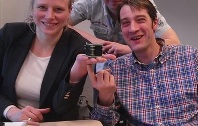 Sometimes, the ducks just line up.
Sometimes, the ducks just line up.
Ladies and gentlemen, we have our first “space” product. (If you count middle space, that is, not the mythic outer space.) Acme Advanced Materials has produced high-grade wafers of silicon carbide, aboard flying laboratories. Why do we care?
Simply put, silicon carbide makes lots of ducks line up: SiC power switches will make components in EVs, efficient lights, wind turbines/solar arrays, and the grid in general a lot smaller and tougher, which means more efficient and inexpensive. All the way down to the wall adapters for our laptops, and possibly on into those computing devices as well. To put things in perspective: Toyota and Honda didn’t build the first hybrids until compact, efficient power switching circuits became available. Even better switches will continue our drive towards the future.
Most electronics are grown on silicon wafers; wafers are then cut into the chips that handle more and more of our lives. Chips only got practical as silicon got purified enough to take current, without heating or noise. But there’s a problem: even pure silicon only takes so much juice, without making heat and noise anyway. Enter SiC. Continue reading


 I’m not just a geek, I did some consulting on a “drone” project, though it was general work and would apply to a manned plane.
I’m not just a geek, I did some consulting on a “drone” project, though it was general work and would apply to a manned plane.
 I hear it again and again: ‘we aren’t even past the Moon yet.’ And by “we,” they mean “the uninformed.”
I hear it again and again: ‘we aren’t even past the Moon yet.’ And by “we,” they mean “the uninformed.”
You must be logged in to post a comment.